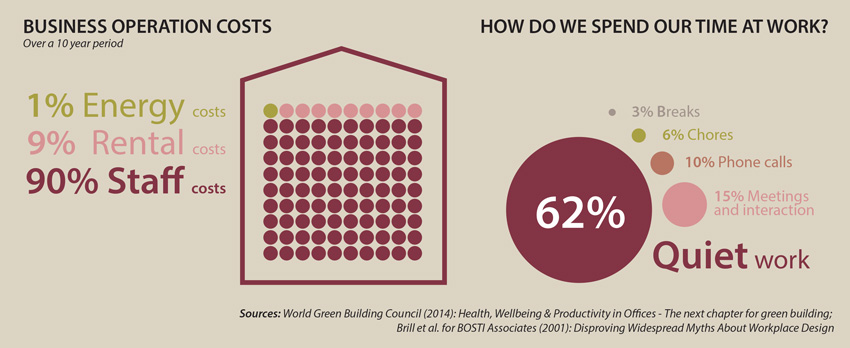Optimizing Acoustics for Effective Sound Design and Performance
Learning Objectives:
- Assess the impact of noise on physiology, comfort, health, mental capacity, behavior, and productivity.
- Describe the myths and truths in the design world as they relate to acoustic building practices.
- Recognize how ceiling panels with high noise reduction coefficient ratings (NRC), such as those made of stone wool, can lead to compliance with the building standards, guidelines, and rating systems from multiple perspectives.
- Explain the mechanics of optimized acoustic design and differentiate between optimizing absorption and optimizing blocking using modular, suspended, acoustic ceilings, and other architectural components.
Credits:
Anyone who has ever tried to work in a busy office or get some sleep during a hospital stay knows that the noise surrounding us—whether it’s your coworker’s exuberant laugh or machines beeping down the hall—can affect our mental and physical well-being, not to mention productivity and general state of satisfaction with our environment. As awareness of the impact noise has on our daily lives increases, it’s only logical that building standards and guidelines are becoming more stringent when it comes to acoustic requirements. In order to meet many of these higher-performance criteria, architects and designers need to make a concerted effort to consider how every structure, surface, fixture, material, and even gap plays a role in the way sound is experienced. For the best results, this means focusing on the true strength of acoustic ceiling panels: noise absorption.

All images courtesy of ROCKFON
New optimized acoustic design approaches can help architects and designers meet and exceed more stringent industry standards, guidelines, and requirements in modern building construction.
Designers and architects are now tasked with the challenge of navigating the wide range of ceiling panel solutions available in the marketplace. Although some products attempt to absorb and block noise, there is actually a misconception that ceilings alone can block sound between rooms. The reality is, modular acoustic ceilings by themselves do not have enough mass to block sound. Additionally, ceiling systems will always have substantial noise leaks—created by installing light fixtures and air devices—making them even less effective at blocking sound.
In this course, we will look at the effects of noise, how to determine the type and level of noise mitigation required for a given project, as well as look at the factors that go into meeting and exceeding new industry standards, guidelines and requirements through the latest optimized acoustic design approaches.
Why Acoustics Matter
It is no surprise that noise affects physical and mental health, productivity, and overall well-being. The first step toward an optimized acoustic experience is to understand its importance for our daily lives.

Acoustics have a major impact on business productivity, accuracy, and costs, which can affect resources and the bottom line.
Impact of Noise on Physiology, Comfort, and Health
The National Institute for Occupation Safety and Health asserts that ambient noise levels affect people’s health by increasing general stress levels. Continued exposure does not lead to habituation; in fact, the effects worsen. More specifically, according to the World Health Organization:
Noise seriously harms human health by causing short- and long-term health problems. Noise interferes with people’s daily activities at school, at work, at home, and during leisure time. It can disturb sleep, cause cardiovascular and psychophysiological effects, hinder work and school performance, and provoke annoyance responses and changes in social behavior.1
The clinical manifestations of stress occurring with noise, that is, negative physical impacts on the human body from noise, are numerous and should not be taken lightly. They include:
- Increased heart rate
- Elevated blood pressure
- Dilation of pupils
- Increased respiration rate
- Increased muscle tension
- Fatigue and nausea
- Heart attacks
- Increased ulcer formation
- Intestinal motility changes
- Increases in adrenaline
The effects go beyond the physical. Additionally, the negative mental and behavioral effects of noise include:
- Increased aggressiveness
- Impatience and nervousness
- Decreased helping behaviors
- Lowered attention span
- Decreased problem solving
- Memorization problems
- Comprehension problems
- Neurotransmitter deficiencies
- Interpersonal problems
- Social behavior problems
Impact of Noise on Productivity and the Bottom Line
With all that in mind, it is essential to recognize the potential productivity and financial impact of bad acoustics. While some people still view noise as only a minor, short-term annoyance, appreciating the major impact of acoustics on business productivity, accuracy, and costs can affect resources in a big way.
The numbers speak for themselves. Studies have shown that 90 percent of business operation costs are tied to staff or employees, compared to only 1 percent for energy usage. Those employees spend 62 percent of their time needing to do quiet work. In other words, good or bad acoustics affect 90 percent of an organization’s resources 62 percent of the time.2,3










